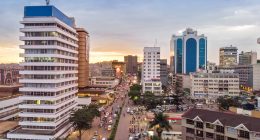The last month of the rainy season has been characterized by heavy rains and floods across Uganda and the rest of East Africa. Social media reports have been awash with pictures and videos of flooded and collapsed roads, blocked drainage systems and broken bridges across the country. On the regional front, the Kigali–Gatuna highway suffered major structural damage due to the heavy rains- that resulted in failure of the embankments and slopes upon which the road was built. In Kenya, over 40 people died and scores are still missing after the catastrophic failure of Patel Dam in Nakuru County. These few examples of infrastructure failure due to climatic conditions, clearly indicate the need for engineers, policy makers, political leaders, media and local communities to develop robust climate resilience mechanisms for both infrastructure and ecosystems.

Photo: The East African
Climate resilience, according to Wikipedia can be generally defined as the capacity for a socio-ecological system to: absorb stresses and maintain function in the face of external stresses imposed upon it by climate change, as well as; adapt, reorganize, and evolve into more desirable configurations that improve the sustainability of the system, leaving it better prepared for future climate change impacts.
The United Nations is championing the implementation of the Sustainable Development Goals (SDGs) agenda for the next decade. Of the seventeen SDGs, there are four SDGs primary focused on infrastructure development, such as, SDG7 which is on affordable and clean energy, to ensure access to affordable, reliable, sustainable and modern energy for all. Uganda’s immense investment in dams and hydro power plants (Isimba and Karuma) is under category. Thus the vitality of infrastructure that is designed and constructed to be climate resilient. The Uganda Electricity Generation Company Limited (UEGCL) is also taking a lead role in developing Dam Safety Management Systems to ensure safety of the dams during their entire design life. This goes a long way in protecting the communities that reside around the dams along the river Nile.

Photo: Construction Review
SDGs9 and 11 are focused on industry, innovation and infrastructure, sustainable cities and communities respectively. This involves agencies like Uganda National Roads Authority (UNRA), Uganda Communications Commission (UCC), Kampala Capital City Authority (KCCA), Uganda Investment Authority (UIA), National Housing and Construction Corporation (NHCC) etc. building resilient infrastructure, promote inclusive and sustainable industrialization and foster innovation across the country. Furthermore, these two sustainable development goals require communities to be made inclusive, safe, resilient and sustainable, so as to improve the quality of life whilst safeguarding the environment and ecosystems. Sustainable growth cannot be achieved while we’re still facing loss of property and business in economic hubs across the country due to floods every time there are heavy rains.

Engineers, technicians and technologists under their umbrella organizations; Uganda Institution of Professional Engineers (UIPE) and Engineers Registration Board (ERB), ought to take centre stage in these initiatives and design frameworks to build, operate and maintain public infrastructure that is climate resilient throughout its design life. Failure to adopt climate resilience paradigms on infrastructure projects presents huge potential for loss, considering the high capital and investment costs incurred when developing public infrastructure. Engineers also ought to liaise and partner with social workers, environmentalists, media and political leaders to adopt climate resilience toolkits in their projects right from the design to the construction, operation and maintenance. This goes a long way in ensuring that our infrastructure is safe to serve the purpose for which is was constructed.







